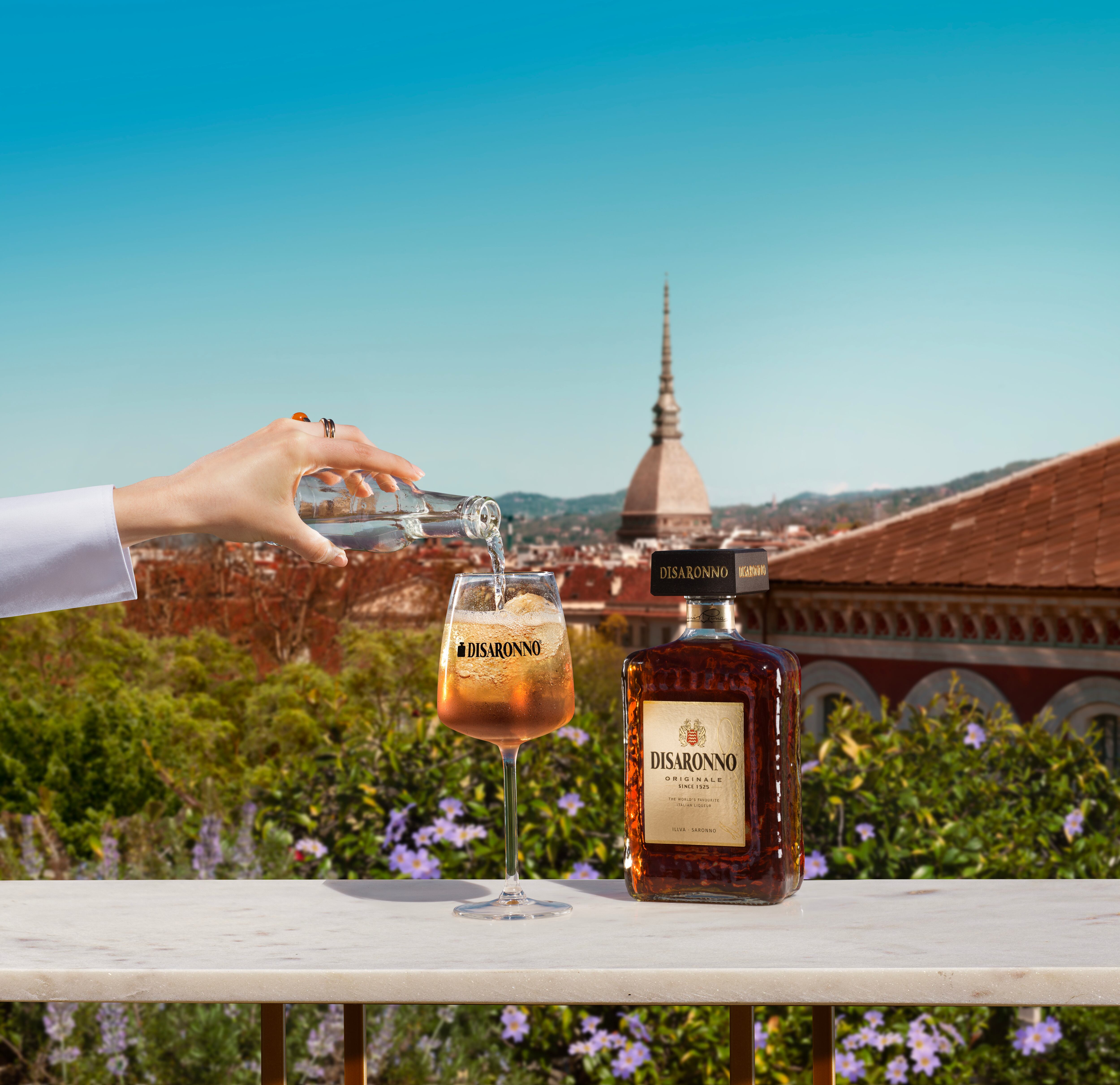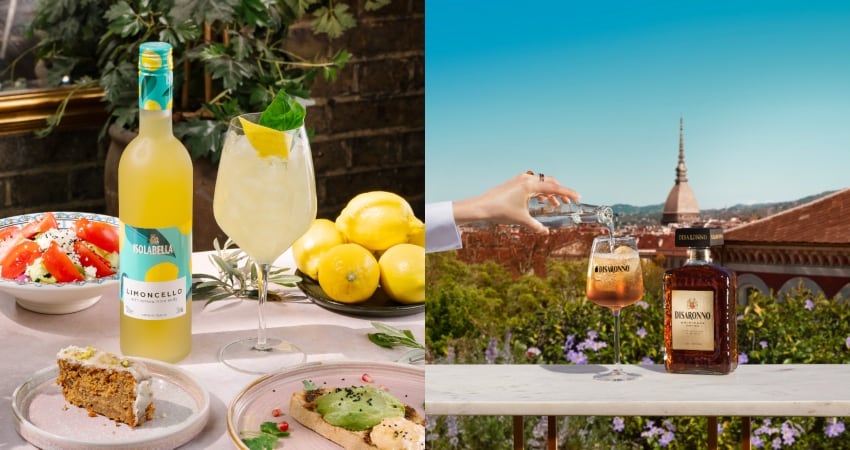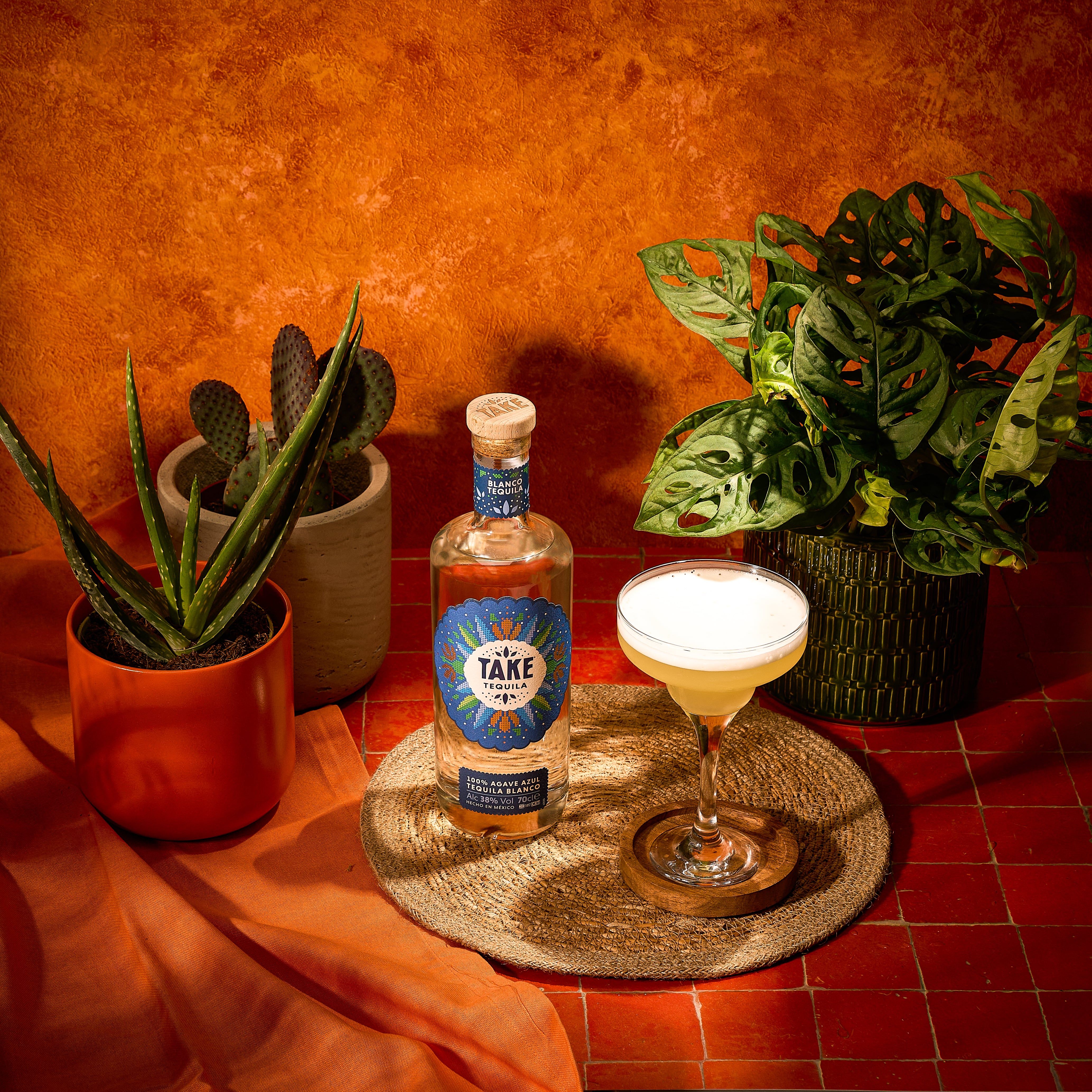It’s a chance for other drinks categories to shine, and spirits could be the category that’s ready to step up to plate.
The spritz serve, led by Aperol, is already a major drinks trend of our times and this year’s early burst of fine summery weather has amplified its potential to go further as consumers look for alternative, refreshing long drinks to sip while the sun goes down.
Promotional content

Gen Z’s growing preference for lower-alcohol options is reshaping drinks menus across the on-trade - and liqueurs are stepping into the spotlight. With naturally lower ABVs than traditional spirits, brands like Disaronno are proving ideal for creating lighter, more sessionable serves that align with this shift in consumer behaviour.
Disaronno Originale, for example, is being championed in simple, stylish serves such as the Disaronno Spritz - a mix of equal parts Disaronno and soda water, finished with a twist of lemon zest. It’s refreshing, easy to prepare, and perfect for summer sipping.
While it’s long been enjoyed over ice, Disaronno also adds depth and its signature almond flavour to cocktails, offering versatility and standout appeal on any back bar.
Visit https://www.disaronno.com/en-gb/ to learn more.
Disaronno Spritz Recipe
Ingredients
50ml Disaronno Originale
25ml lemon Juice
Top with soda water
Method
Build in a balloon or spritz glass over cubed ice.
Serve garnished with an expressed lemon zest
The relative low ABVs of brands that feed into the spritz trend – compared to full-strength rums, whiskies and vodka – chime with prevailing consumer preferences for lighter drinks and moderation.
“Hats off to Aperol over the past few years,” says Nick Gillett, managing director of premium spirits importer Mangrove Global.
“That and the gin and tonic in big goldfish-bowl glasses has led to people wanting a refreshing long drink they can make last over a session.
“It fits in with the general trend of drinking slightly earlier in the day and the move away from late-night high-energy.”

Gillett says the trend is evolving to fruit-led serves such as the Hugo elderflower spritz, for which it has a Giffard elderflower liqueur, and limoncello, a category where it markets the Di Capri brand in the UK.
He thinks this is filling a hole left by the dropping off of flavoured gin liqueurs. “Some of those flavours have been dialled back and spritzes have come into that arena.”
Another advantage many spritz-skewed spirits have is that lower ABVs also mean more favourable price points and/or margins because of lower duty, an attraction in times when spirits have been clobbered hard.
Governments of both hues have targeted spirits for duty cuts in recent times, a 3.6% rise imposed by Rachel Reeves in February of this year coming on top of a 10.1% increase under the previous Tory administration in October 2023.
It’s perhaps little surprise that the main spirit categories have seen dips in performance as the Treasury has targeted the sector at the same time as wider economic headwinds have pushed the on-trade into reverse.
CGA figures for the year to last October for The MA Drinks List show the top 10 on-trade spirits all seeing falling volumes, with Gordon’s and Jack Daniel’s – the number two and three brands – down by double digits.
Value sales were up for five of the top 10 – Absolut, Disaronno, Kraken, Bell’s and Courvoisier – but only by levels that suggested the extra duty that was doing a lot of the heavy lifting.
“What people won’t do is pay a very high price for a poor-quality experience.”
Nick Gillett, managing director, Mangrove Global
The leading 10 gin bands were all in double-digit volume decline and all down in value.
Bacardi Spiced was the only Top 10 rum brand in volume growth, suggesting that the theory that rum could replicate the phenomenal growth seen by gin several years ago has stalled.
Liqueur and speciality brands fared slightly better overall, but seven of the top 10 were still in volume decline. The outliers were category leader Baileys, up 10.5%, Kahlúa with an increase of 30.6% and Tequila Rose, buoyed by the fashionableness of agave, which rose 16.5%.
But even Tequila – a global phenomenon in recent years to the point where allocations were restricted in some markets – found the going tough in the UK on-trade seven of the top 10 were in volume decline and four were down in value.
The temptation in such a climate might be to cut corners with serves and go for cheaper products that offer more favourable price points, but Gillett suggests this may be an own goal.
“What people won’t do is pay a very high price for a poor-quality experience,” he says.
“If people are going out one time less a month or week, you need to capture that and deliver. The danger is if you cut back too far you don’t have an offering people will come back for.”
Back to classics
Rory O’Sullivan, brand ambassador at Disaronno International UK, also urges a premium quality approach. The company’s armoury includes the Disaronno amaretto brand – the historical backbone of the Amaretto Sour – and Tia Maria, the coffee liqueur used in the original Espresso Martini.
“We definitely back the classics,” O’Sullivan says. “They’re widely recognised everywhere, and we like to over-complicate or simplify, depending whether we’re talking to high-end bars or mainstream pubs.
“We have a dedicated Bar Academy team to people those serves with videos and PDFs, to try to make it really easy for people to have that level of training.
“It gives outlets the confidence to make those drinks and gives the customers consistency. If they go to a bar in London or Manchester they know what they’re getting.”
Despite the commitment to classic cocktails, Disaronno has also looked to tap into the spritz craze, with the launch of Isolabella Limoncello nationally in JD Wetherspoon, and with a spritz serve for its main amaretto brand.
It combines 50ml of Disaronno and 25ml of fresh lemon juice, topped off with soda water.
“We didn’t put in Prosecco so we could give customers a really good GP drink. Spritzes don’t always have to be about a wine base. It’s simple to make and the cost of ingredients is low.
“Consumers are going away from short drinks and want a little bit more liquid as part of that whole value for money thing.
“They’d rather sit there with something they can take their time with and Gen Zs are starting to go for a sweeter profile of spritz.”

Guy Dolden, head of spirits buying at Venus Wine and Spirits Merchants, says pubs should consider running specific menus featuring a range of spritz serves, as they might witch cocktails.
“Creating a spritz menu can help pubs engage and give customers a refreshing take on popular Italian-style drinks,” he says.
Spicy Margarita (suggested by Guy Dolden, head of spirits buying at Venus)
Ingredients
45ml Patrón silver tequila
22.5ml triple sec
22.5ml fresh lime juice
5ml agave syrup
Hot sauce or chilli powder
Tajin
Method
Depending on the customer’s heat preference, add hot sauce or chilli powder to the shaker. Rub a wedge of lime around the rim of the glass and coat the rim with Tajín for a vibrant pop of colour. Shake the liquid ingredients. Fill a glass with ice and strain the drink into the glass. Garnish with a wedge of lime or a spicy pickled jalapeño.
“They’re also food-friendly, so pair them with summer dishes such as charcuterie boards and grazing platters.
“When presented well, they are pleasing to look at, so suit the social media generation and are lighter in alcohol, resulting in a middle-ground option for those who prefer lower-abv drinks but still want an elegant, colourful, fun beverage.”
Gavin Troman, spirits category manager at Booker, says “rotating cocktails seasonally keeps things fresh and allows you to introduce new drinks and promote key spirits, creating natural upselling opportunities”.
He adds: “We’re seeing pubs create limited edition cocktail menus tied to cultural moments. Cocktail weeks, local live music events, and sporting tournaments are all opportunities to create sociable drinks-led activations to make the most of your back bar.”
Matt Towe, head of marketing at Bidfood’s alcohol arm Unity Wines and Spirits, acknowledges the power of lighter serves in the summer but says there’s a danger in too much typecasting.
Hugo Spritz (suggested by BidFood)
Ingredients
40ml St-Germain elderflower liqueur
60ml Prosecco
60ml soda water
Lime wedge
Sprig of fresh mint
Method
Put ice into a large glass. Pour in the elderflower liqueur and add eight mint leaves. Top up with the Prosecco and soda water. Stir to combine. Garnish with a sprig of mint and the lime.
“It’s a long-standing assumption that light spirits sell in summer, while dark spirits are stuck in the winter,” he says.
“While this does pose some truth, it’s far from a set rule. Undoubtedly, cocktails like Mojitos and Passionfruit Martinis are most popular in the summer with their light and refreshing profiles, while winter warmers tend to lean more towards heavier spirits.
“In reality, though, consumers drink what they like all year round. Gin fans don’t stop ordering G&Ts in October, and the success of Aperol Spritz – now one of the UK’s top 10 cocktails – proves that even the most seasonal-seeming serves can defy expectations.
“What really matters is how drinks are marketed and presented at the bar.
“With 80% of customers arriving at the bar still undecided on their drink of choice, a well-placed prompt or an upsell can have a major impact on spend and satisfaction.
“If a customer approaches the bar with a G&T on their mind, can you turn that concept into a gin cocktail and increase your GP?”
Simple serves
That Boutique-y Whisky Company bottles limited, small batch releases from the US, Asia, Australia, Europe and the UK, which provide instant talking points for whisky fans.
Head of marketing Adrian Lugg provides some pointers for how to bring such niche products into the mainstream arena.
“Think about different ways to create experiences and maximise value, like sharing serves,” he says.
“Recently we’ve looked at things like carafes, pitchers and punches to create a different experience.”
He adds: “Simpler serves like highballs help to reduce cost of serve, improving margins. We encourage people to think differently about whisky and have created World Whisky Blend, devised with highballs in mind, taking whisky drinking beyond neat serves or traditional cocktails, such as with coconut water.”
Brian Luftman, co-founder of Never Say Die, a brand that takes whiskey distilled in Kentucky and matures it in the UK, says partnerships between brands and operators are key to mutual success.
“We do everything we can to support our on-trade partners,” he says. “That includes offering discounted pricing where possible and using our PR and social media channels to spotlight venues that incorporate Never Say Die into their drinks offers and customer experience.
“We love driving our fans to bars where they can discover the brand in the wild.”
He says the brand’s “standout serve” is the Black Stallion (see below) which “works beautifully either as a signature cocktail or as an after-dinner option”.
Black Stallion (suggested by Never Say Die whiskey)
Ingredients
60ml Never Say Die rye
30ml Cynar
One or two drops Chartreuse Élixir Végétal
Two dashes of chocolate bitters
Half a bar spoon Luxardo Maraschino cherry liqueur or syrup
Method
Add the ingredients and stir clockwise for 30 seconds to dilute and combine the flavours, before straining into a coupe glass. Garnish with a maraschino cherry.
While the world has gone spritz crazy, some operators are still finding value through more traditional serves and the major spirits categories.
Cheshire Cat Pubs & Inns won Best Drinks Offer at this year’s Publican Awards, and champions particular spirits categories at certain pubs within the group.
“Gin is still the biggest seller across our estate,” says managing director Tim Bird. “We turnover probably around £150,000 [on gin].
“It’s flat because the gin has bubble has burst, mainly around flavoured gin.
“But the traditional gin and tonic and the advertising around Tanqueray has taken people back to their roots as gin drinkers. They’ve done their experimentation and they’re supporting local distilleries, but at the same time they still want their classic Tanqueray and tonic.
“The biggest growth is in whisky. Whisky is still only a quarter of gin in our business but 27% up like-for-like.
“We’ve run whisky tasting evenings at the Bull’s Head [in Mobberley, Cheshire] matched with food. It’s just shown a light on what is possible.
“It’s real mixture of styles too. The Irish market has picked up, as have Japan and English whisky. Scotland has realised there’s a fight on, and they’re thinking about how they’re ageing and what barrels they use, so you have port, Amarone and Sauternes-aged whiskies, and that’s influencing flavours.
“Rum is up 23% like-for-like and flavours have made it a bit more entertaining. It was dark, light, spiced and gold but the flavoured rum market has exploded, such as coffee, banana and hazelnut, which you can pour over ice cream and do affogatos, rather than it just being about amaretto.”
Bird urges fellow pubs not to overlook the summer classics just because new stuff has come along.
“We never stop thinking about the trends, but they have to match the gardens you have and the feel of the pubs.”
Tim Bird, MD, Cheshire Cat Pubs & Inns
“Every pub should be doing Pimm’s, but with the right garnish of four key ingredients: orange, cucumber, fresh mint and strawberries. Sometimes it’s done with lime or lemon, which can really taint it.
“It’s really important with spirits that you know what the traditional garnish is. If they’re new brands ask the gin-maker, or whoever, what the preferred garnish is – and hope they don’t say Irish seaweed, because you want to be able to get hold of it and not pay a fortune for it.”
Each Cheshire Cat pub has its own summer spirits offering lined up, aligned to the location or trading style.
At the Fitzherbert Arms in Swynnnerton, Staffordshire, they’re marking the centenary of nearby Stoke-on-Trent with themed cocktails: the Bennett Martini, the Wedgewood Paloma, the Five Town classic Mojito and so on.
“We never stop thinking about the trends, but they have to match the gardens you have and the feel of the pubs,” Bird adds. “Tequila is having great growth in bars but for the first 13 of our 15 years we didn’t even stock it because it just wasn’t appropriate to our customer base.”



